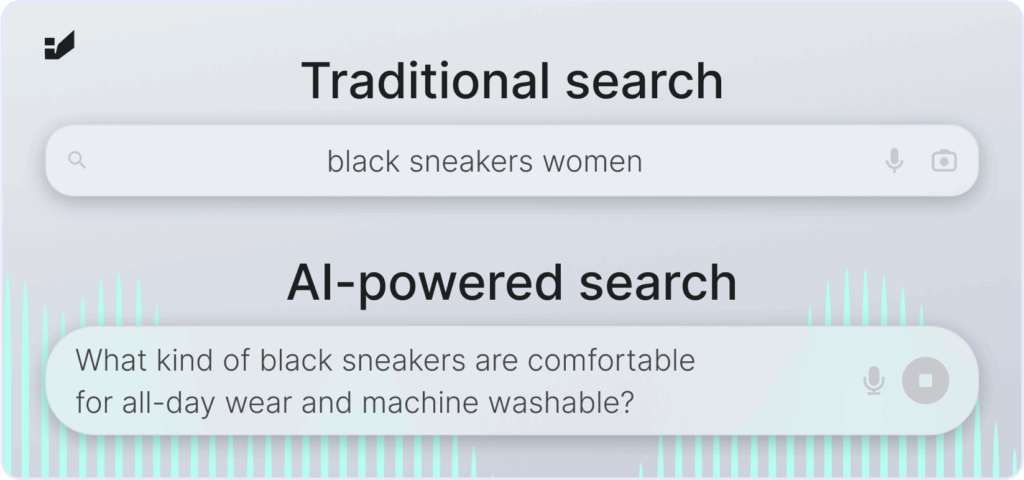Are your product descriptions ready for AI-driven search assistants?
Product descriptions became the data foundation that AI-driven systems rely on to match intent-driven queries with the right products. Learn how to get them ready for AI search.

Not long ago, product descriptions were primarily written for search engines and sprinkled with keywords to secure rankings. Today, customers interact with online stores in a very different way. Instead of typing “black running shoes” into a search bar, they ask AI-powered assistants questions such as: “Which lightweight shoes are best for trail running in wet conditions?” or “Show me vegan skincare under $30 available for same-day delivery.”
This shift is massively affecting the product discovery process.
Product descriptions are no longer just marketing content – they are the data foundation that AI-driven systems rely on to match intent-driven queries with the right products.
The question is: are your product descriptions ready for this new way of search?

How AI is reshaping product search
AI-driven search assistants combine natural language processing (NLP) with machine learning (ML) to interpret customer intent. Instead of simply matching keywords, they analyze context, attributes, and usage scenarios.
In traditional search, a user would look for “black sneakers women”, whereas when they’re in conversation with an AI-powered chat, they may ask: “What kind of black sneakers are comfortable for all-day wear and machine washable?”

What does that mean for e-commerce?
The role of product descriptions in e-commerce has become increasingly important with the rise of AI-powered tools. They now serve as a key source of structured information for AI systems. If your descriptions lack detail, your products may never surface in ai-powered results.
Why AI-optimized descriptions matter
1. Higher conversions
Platforms with AI-powered search report up to four times higher conversion rates compared to traditional keyword-based search. The closer the match to customer intent, the faster they purchase.
This means product descriptions should anticipate customer needs and reflect natural language queries. For example, instead of simply saying “waterproof jacket,” a description that mentions “keeps you dry during heavy rain” aligns better with how customers phrase their searches and increases the chance of conversion.
2. Better personalization
AI assistants adapt results in real time, based on multiple factors including browsing history, purchase intent, and even location. Descriptions that highlight use cases (“perfect for winter hiking” or “ideal for sensitive skin”) allow AI to recommend products with greater precision.
By providing a broader context for each product, you can make it easier for AI to match products with individual shoppers. Personalization works best when product descriptions address different scenarios, lifestyles, or needs. This makes the shopping experience more customer-centric and drives stronger brand loyalty, as customers feel the product was “made for them.”
3. Enhanced visibility in AI ecosystems
From Google Search Generative Experience (SGE) to marketplaces like Amazon and Zalando, AI-first discovery is becoming the norm. Descriptions rich in attributes and context stand a far better chance of being highlighted in these environments.
If your descriptions lack detail, AI systems may struggle to recognize the relevance of your products, pushing them lower in rankings. Adding specifications, benefits, and contextual phrases helps ensure your products are understood and surfaced in AI-driven search and recommendation engines, making your brand visible across various search environments.

How to write AI-ready product descriptions
1. Be comprehensive and precise
Go beyond surface-level marketing. Include:
- Technical details (materials, dimensions, ingredients, specs)
- Functional benefits and use cases
- Limitations (not waterproof, requires USB charging, etc.)
- The more complete the description, the more likely AI will match it to nuanced customer queries.
2. Use structured data
Implement schema.org markup for price, availability, size, ratings, and shipping. Structured data acts as a direct language for search engines and helps AI precisely understand your catalog.
3. Write in natural, conversational language
AI thrives on natural phrasing. Descriptions should feel like answers to questions.
Instead of: “Leather jacket, black”
Try: “This black leather jacket is designed for everyday wear – it protects against wind and pairs easily with both jeans and formal trousers.”
4. Maintain consistency across languages
For multilingual e-commerce, poor translations are costly. If “running shoes” becomes “sport shoes” in another language, AI may misinterpret the product. Consistent terminology ensures relevance across markets.
5. Leverage user-generated content (UGC)
Customer reviews, Q&A, and FAQs provide real-world, conversational phrasing. Integrating them into product pages enriches AI’s understanding of how people talk about your products.
6. Include contextual and real-time data
Availability, shipping options, and promotions matter. An AI assistant can suggest: “This jacket is in stock in your size and can be delivered tomorrow.” But only if that data is present in your product content.

Beyond text: the rise of multimodal AI
Tomorrow’s search won’t rely on text alone. With multimodal AI, customers will combine images, voice, and text: uploading a picture of their old backpack and asking for a waterproof replacement.
To prepare:
- Optimize product images with descriptive alt text.
- Add metadata to videos showcasing product use.
- Ensure media aligns with product descriptions for cross-validation.
Visual search is growing fast – and AI will use descriptions plus metadata to make sense of it.
Read more about How fast AI is really growing.
A practical checklist for AI-ready descriptions
- Each product has a detailed, accurate description (features + benefits + use cases).
- Structured data (schema.org) is implemented and regularly updated.
- Content uses conversational, natural phrasing.
- Translations are consistent and precise across markets.
- UGC (reviews, FAQs) is visible and integrated.
- Images and videos are tagged with alt text and metadata.
- Availability, delivery, and promotions are clearly stated.
The future of AI-powered product content
AI-driven assistants are not a futuristic trend – they’re already shaping customer journeys. Product descriptions are evolving from static sales copy into dynamic, data-rich assets that power personalization, voice search, and hyper-localized recommendations.
Businesses that adapt now will build a lasting advantage:
- Stronger visibility in AI-powered search ecosystems
- Faster, more relevant customer matches
- Higher trust, satisfaction, and conversion rates
If your product descriptions are still short, generic, and written only for traditional SEO, you’re risking falling behind. In the age of conversational commerce, rich, structured, and AI-ready product content becomes the new standard.



